Navigating the Challenge of a Lost Cockatiel: A Comprehensive Guide

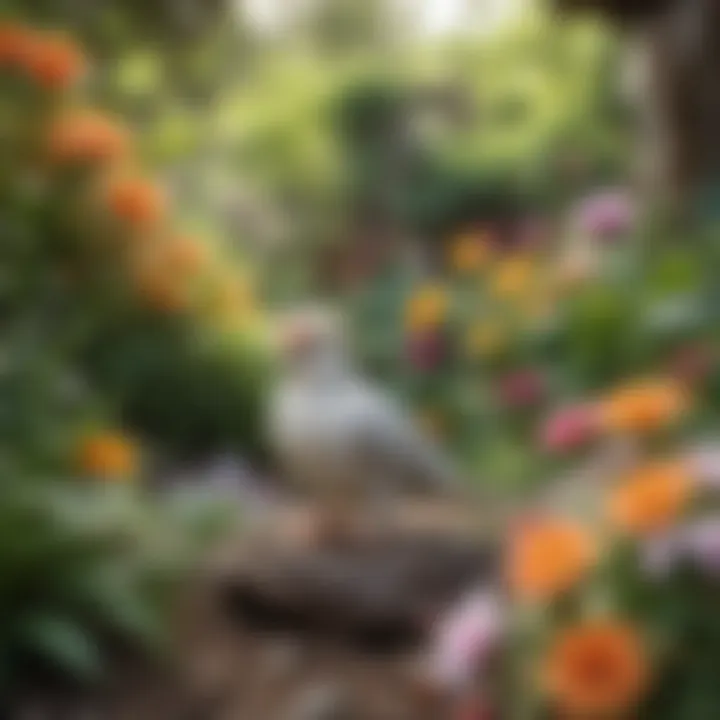
Intro
Experiencing the loss of a cockatiel is an emotional and distressing event. Many owners feel a strong connection with their pets. Losing a bird can stir deep feelings of helplessness and fear. Therefore, it is crucial to understand both preventative measures and effective steps for recovery.
This guide aims to enhance understanding about the best practices following the loss of a cockatiel. The keys to safeguarding these pets include suggestions on daily care, behavioral insights, and general welfare. Each part of the guide is designed to inform and equip important knowledge. Every section has value in the journey toward both prevention and recovery.
Care Tips
Taking care of a cockatiel requires commitment. Like any pet, daily routines are vital for its health and happiness. By establishing consistent daily care and proper environment setup, you decrease the likelihood of a loss.
Daily Care Routines
Daily routines provide stability for cockatiels. They require fresh water and qualitative food every day. Additionally, a few minutes of interaction helps in maintaining trust. Regular exercise should also be a key part of each day.
Cage Setup and Maintenance
An optimal cage setup is necessary. It is important the cage is spacious enough for bird to flt comfortably. A blend of perches, toys, and food placement increases stimulation. Maintain cleanliness in both cage and surroundings. Dirty conditions can lead to health problems.
Hygiene and Cleaning Practices
Good hygiene practices protect both pet and owner. Schedule regular cage cleanings and discard spoiled food, it creates a safe space for your cockatiel. Use bird-safe cleaning supplies to avoid harmful toxins.
Seasonal Care Adjustments
Adapting routines for seasonal changes is also important. In colder months, make sure the cage placement is warm without drafts. During hot months, hydration is essential, so change water more frequently. Understanding seasonal needs keeps your cockatiel safe.
Behavioral Insights
Understanding a cockatiel's behavior can provide significant insights into their happiness levels and potential behavioral issues. Observing body language helps interpret their emotions effectively.
Understanding Bird Body Language
Cockatiels express themselves through various movements and sounds. Fluffed feathers signal relaxation, whereas a puffed-up bird might feel discomfort. Quick movements or excessive screeching can indicate aggravation or distress.
Common Behavioral Issues and Solutions
Take time to recognize common problems inside your pet's behavior. For instance, excessive feather picking can signify stress or boredom. Solutions include increasing interaction time and restructuring the cage environment to reflect a more engaging atmosphere.
Positive Reinforcement Techniques
Using positive reinforcement is an effective method to encourage desired behavior. Reward the cockatiel during training sessions using its favorite treats. Consistency is vital for this to work well.
Social Interaction Needs
Cockatiels thrive in social settings. Daily interaction enhances trust and emotional bonds. They benefit from activities involving parent interaction and play. This sense of companionship encourages well-being and decreases feelings of anxiety during absence.
Nutrition Guides
A balanced diet plays an important role in health. Knowledge of an appropriate diet makes a significant impact on a cockatiel's well-being. By understanding its dietary needs, owners can provide proper nutrition.
Essential Diet Components
Key components of a suitable diet include high-quality pellets, seeds, fruits, and vegetables. Thoughtful mixtures promote essential nutrient consumption. Equally important, certain items like fresh greens offer valuable hydration.
Safe and Toxic Foods
Caution is required around what foods cockatiels can consume. Common safe foods include cooked pasta, carrots, and apples. However, toxic substances include avocado, chocolate, and caffeine. Researching toxins is necessary.
Supplements and Treats
Supplements may benefit cockatiels. Calcium blocks or vitamin-enhanced seeds can fill nutritional gaps. Treats add encouragement M ts for a cockatiel who responds well to training.
Feeding Strategies for Different Species
Unique feeding strategies may suit distinct cockatiel varieties based on their needs. Adjust portion sizes based on individual activity levels. Make feeding flexible to ensure balanced consumption.
Wellness and Health
Health checks are imperative for cockatiel owners. Preventative measures and keen observation keep potential illnesses at bay.
Routine Health Checkups
Regular checkup with avian veterinarians preserves health. vaccinations keep cockatiels fortified against diseases.
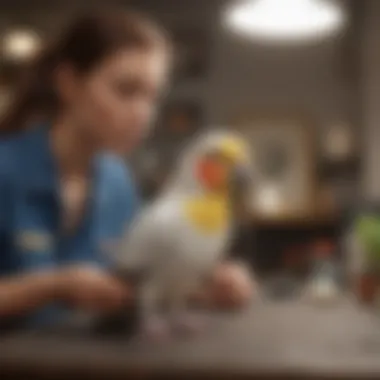
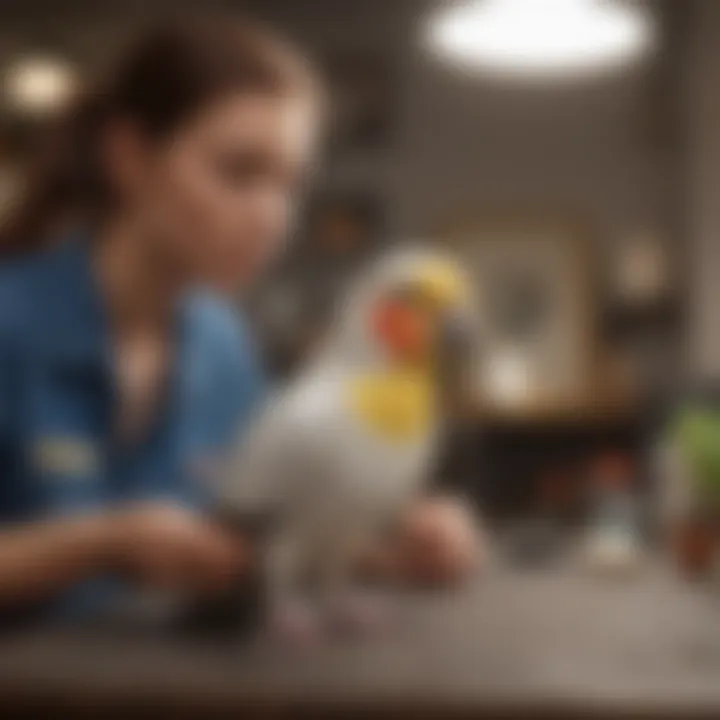
Identifying Symptoms of Illness
Typical sickness signs to watch include lethargy, changes in appetite, or feather loss. Early detection is better than delaying a veterinary visit.
Preventative Care and Vaccinations
Preventative care is vital for your cockatiel. Keep active conversations with veterinary staff regarding ideal vaccination schedules. A well-informed pet owner is a confident advocate.
Mental and Emotional Well-being
Address saying that mental care, just like physical health, matters in overall pet care. Interactive toys, songs, and more add novelty to their lives.
Enriching Activities
Providing a range of activities adds enrichment of life to cockatiels. Birds with stimulation are less likely to exhibit negative behaviors.
Toys and Playtime Ideas
Variety in toys captures attention. Swinging, climbing structures, tunnels add entertainment to their day. Rotate toys frequently to keep interest alive.
Training and Tricks
Engaging in simple training provides mental exercise. Train basic actions fosters both intelligence and relationship. Rather than pushing too hard, KEEP it light and enjoyable for them.
Outdoor Activities and Interaction
Choosing outdoor time can significantly boost mood. Supervised outings allow exposure to new experiences. However, limited time is ideal to lower overwhelm.
DIY Projects for Mental Stimulation
Consider simple DIY projects because they foster creativity. Simple wood sticks or bundles of paper can construct ideal sensory elements. Integrating tactile materials encourages a more engaging playtime environment.
Remember, ensuring your cockatiel's care and engagement can promote a secure and content environment that decreases risk of loss, benefiting both pet and owner.
Understanding the Cockatiel
The significance of comprehending the Cockatiel transcends mere ownership; it impacts the very essence of caregiving. Grasping the characteristics and behaviors of Cockatiels is crucial for best practices in care and management, consequently preventing potential loss. Understanding these qualities equips owners for appropriate responses during unforeseen instances. This knowledge leads to stronger birds and increased fulfillment for both pets and owners.
Basic Characteristics of Cockatiels
Cockatiels, originating from Australia, are medium-sized members of the parrot family. They possess several unique characteristics that define them:
- Size: Typically, Cockatiels reach an average length of 12 to 14 inches.
- Lifespan: They can live up to 15 years or more with proper care.
- Coloration: These birds display various colors such as gray, white, and yellow, with distinctive crests on their heads.
- Diet: A balanced diet includes seeds, pellets, fresh vegetables, and occasional fruits.
Acquaintance with these basic traits creates a foundation for improved interactions. Owners must note that each individual bird may exhibit slight variations based on genetics and environment.
Common Behaviors
Each Cockatiel has its own personality. Observing these behaviors can lead to better bonding experiences, essential in ensuring their well-being:
- Vocalization: Cockatiels are known for their whistles and chatter, which foster social interaction.
- Head Bobbing: This is a typical action indicating excitement or desire to engage.
- Feather Preening: Regular preening signals comfort in their environment and good health.
Understanding such behaviors allows owners to recognize changes indicating stress or a potential loss condition. Confidence in recognizing these behaviors will become crucial in moments of crisis.
Observing your bird's normal behavior can provide vital clues during stressful situations.
Despite their joyous nature, Cockatiels require specific nurturing to thrive. Enhancing one’s knowledge about these birds translates directly into better living conditions and fewer risks of loss.
Reasons for Cockatiel Loss
Understanding why cockatiels may go missing is essential for every owner. Comprehending these reasons enables proactive measures to prevent such distressing situations and prepares owners for effective responses if their pet does escape. A significant factor is knowing that cockatiels are inherently curious creatures. They tend to explore environments extensively, which can inadvertently lead to various causes of loss.
Environmental Factors
A variety of environmental issues can contribute to the sudden disappearance of cockatiels. These birds thrive in specific surroundings. Factors like open windows and doors can easily provide an escape route. Other elements to consider include:
- Potential hazards: In some environments, there is clutter, like plants or toxic items, that might cause birds to flee in fear.
- Weather conditions: Elements such as wind and storms can disturb a cockatiel’s domain, leading to confusion and escape.
- Predators: Those in backyards or near natural habitats must consider hunting birds, local animals, or even fellow pets, all of which can frighten a cockatiel into flight.
Having knowledge of these environmental details helps owners create safer spaces where cockatiels can exist without risk. Maintaining secure settings enhances the likelihood of keeping these beloved companions from wandering away.
Curiosity and Exploration
Cockatiels are known for their inquisitive nature. They have a strong instinct to explore their surroundings. Coupled with their playful traits, a cockatiel may find intrigue in any small gap or opening.
This curiosity can be a delight but also a risk. Factors include:
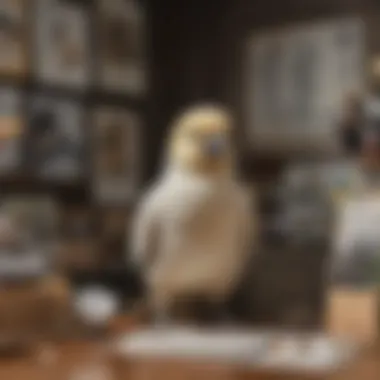
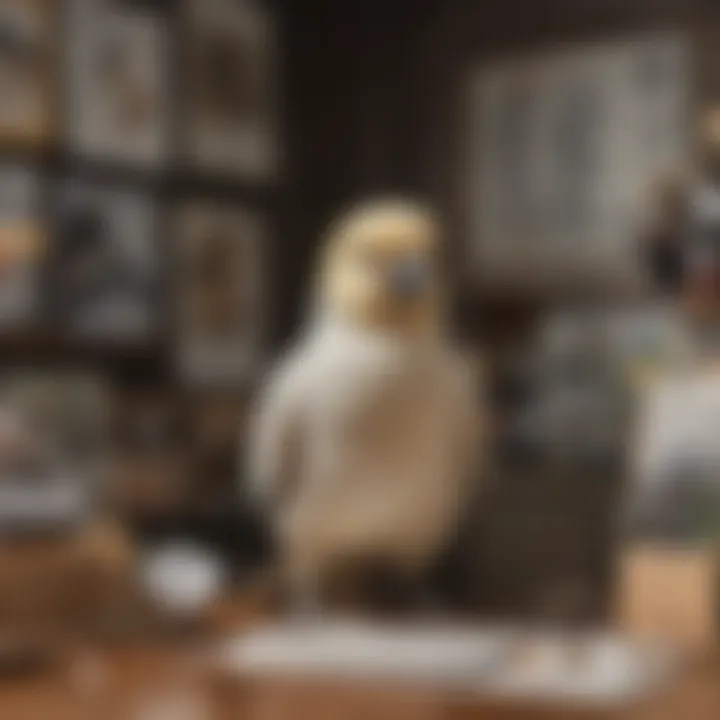
- New environments: If owners introduce new items or change the layout, birds may be tempted to explore unexpectedly.
- Other pets: Mischievousaging house partners can stir curiosity, causing the cockatiel to chase or move toward an exit.
- Charming sounds: Distracting noises, whether from outside or electronic devices, can draw a cockatiel's attention away from safer areas, leading them to indulge their adventurous spirit.
Recognizing this innate desire helps owners understand their pet’s actions better. It also stresses the significance of constant supervision, particularly in unfamiliar or stimulating areas.
Stress and Social Factors
Stress, resulting from both internal and external social factors, can also lead to a cockatiel’s loss. Birds are highly sensitive creatures, often affected by their environment or nearby inhabitants.
Consider the following social aspects:
- Changes in routine: A variation in schedules might make a cockatiel anxious, prompting them to capitalize on any access to leave.
- Interactions with owners: Loud voices or abrupt movements can spur instinctive flight behavior.
- Presence of strangers: New guests or even relocating within a household may induce stress, depending on the familiar setting for the cockatiel.
Understanding their social sensitivities enables owners to reduce stress triggers effectively. Reducing these factors ensures an environment formulates an atmosphere where cockatiels feel secure and safe, minimizing any motivated escape attempts.
Preventive Measures to Avoid Loss
Preventing the loss of a cockatiel requires a comprehensive understanding of its habits and an effort to create an environment that minimizes risk. The essence of preventive measures is not just to prevent actual loss but also to ensure owners have peace of mind when it comes to their pets. Holistic approaches, including creating a safe environment and training for recall, can make a significant difference in the overall bond between the bird and its owner.
Creating a Safe Space
A safe space for your cockatiel is crucial. This includes both physical and psychological elements. Physically, ensure that windows, doors, and any potential escape routes are secure. Screening windows can keep your contents inside, while solid barriers help prevent accidental flights outdoors. Reducing noise and addressing any frightening stimuli can support their emotional needs.
Creating a designated area where your cockatiel can enjoy playtime is important. This should be a safe haven free from hazards, such as toxic plants or small objects that could be ingested.
Consider these actions:
- Utilize perches that allow your cockatiel to observe without feeling trapped.
- Invest in bird-safe toys to keep them engaged and mentally stimulated so that their explorative instincts are properly channeled.
- Monitor their playtime closely to avoid unexpected accidents or escapes.
Finally, provide safe covers for cages at night or when you're not around to monitor them. Birds tend to feel secure in enclosed spaces, which can prevent unwanted attempts to escape.
Training for Recall
Training your cockatiel for recall is an effective method for building trust and ensuring their safety. It's about fedning a reliable system where your pet learns to return to you when called. This method strengthens the bond while simultaneously beneficial if they ever get loose.
Start by using simple commands like
Immediate Actions if Your Cockatiel is Lost
Dealing with a lost cockatiel is one of the most distressing experiences for any owner. The moments following the realization that your feathered companion is missing are critical. Quick and effective immediate actions can significantly aumentar your chances of a successful recovery. Understanding how to react can make the process easier and less overwhelming. Immediate actions can serve as a guiding beacon during a chaotic time and foster a sense of agency in navigating this situation.
Initial Steps
Once your cockatiel is lost, the first thing to do is to remain calm. Stress can cloud judgment and prevent effective action. Start by inspecting the immediate surroundings, looking for places where your cockatiel may have sought refuge. Close off windows and doors to prevent them from flying away further. Listen for any sounds, as your cockatiel may respond to your calling. It is vital not to panic; many pets tend to return to familiar sounds, especially their owner’s voice.
In addition to searching nearby, search your home carefully. Oftentimes, pets can find the tiniest places to nestle into. Check behind furniture, under cushions, as well as high perches where they might feel secure. Use some of their favorite treats or toys to entice them back towards you. Calling out common phrases they recognize will also help capture their attention. Documenting any specific places you're looking may keep your search organized and sweep dedicated to not weekend.
Alerting Neighbors and Community
Next, informing your neighbors about the lost bird is crucial. Cockatiels can traverse quite a distance in a short time, so alerting those nearby is an key component to increasing your chances of recovery. Share details like your bird’s name, color, and any distinctive markings. Give instances on where and when your cockatiel was lost. This type of communication fosters community involvement and helps increase visibility in your search. Don't underestimate a friendly chat with neighborhood members; everyone may be willing to lend a helping hand.
Also, posting a flyer around your local area can make a big difference. A clear photo of your cockatiel, alongside your contact details, should be included on the flyer. Place these flyers at vet clinics, community boards, or any other popular spots in your neighborhood.
Utilizing Social Media and Online Platforms
In today's digital landscape, social media proves to be a valuable tool for reconnecting with lost pets. Utilize platforms such as Facebook and Reddit to spread the word more extensively. Many communities have dedicated lost and found pet groups that can help your search reach a wider audience. Posting in these groups allows your message to potentially reach hundreds, if not thousands, of people, increasing your chances of a hopefully positive outcome.
While posting online, always include a brief description of your cockatiel, accompanied by at least one clear image. Engage effectively by asking users to share your post. Visibility increases greatly when numerous people assist in sharing on their feeds.
Remember that engaging with local resources can also be a part of this social media strategy. Using hashtags that are related to pet loss can help in your outreach. Consider direct messaging local animal shelters and rescues to alert them and check if they’ve seen your cockatiel.
“The emotional landscape of losing a pet informs several recovery strategies, both in the physical searching and support mechanisms that develop from community response.”
By following initial steps, engaging your neighborhood, and leveraging online platforms, you set in motion a series of responses that can streamline your efforts towards locating your lost cockatiel. Each action taken is a step closer towards potential reunion.
Search Strategies
When a cockatiel goes missing, effective search strategies become crucial for reuniting with the lost bird. Searching systematically can save time and increase the likelihood of a successful recovery. These strategies encompass thorough inspections of the surroundings and engaging with local resources. Understanding and implementing these approaches can foster not just a physical reunion but an emotional one as well.
Thorough Inspection of the Surroundings
Inspecting the area where the cockatiel was last seen is the first step in any search. Cockatiels may take shelter in nearby trees, bushes, or even under decking. Here are specific aspects to consider during this search:
- Look up and down: Cockatiels often fly high because they perceive certain angles as safer. Check trees and rooftops first, then move on to lower items like bushes and flowerbeds.
- Utilize sound: Softly call out your cockatiel's name and use familiar sounds they might recognize. Sometimes, a bird will respond to its owner’s voice. Alternatively, try to simulate common sounds they are used to every day, like the sounds of their toys.
- Time of Day: Approach the search early in the morning or during late afternoon when the environment is quieter. Enhanced tranquility allows for the cockatiel's natural instincts, like instinctual calls, to emerge.
- Check unusual spots: A cockatiel may find small, hidden areas comforting. Lift items like flower pots or small furniture to uncover potential hiding spaces.
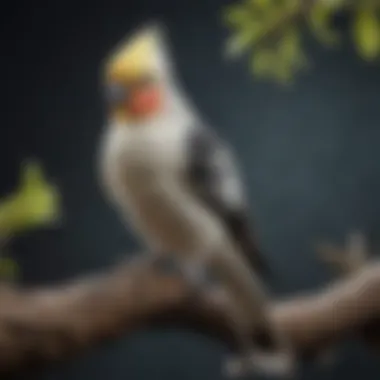
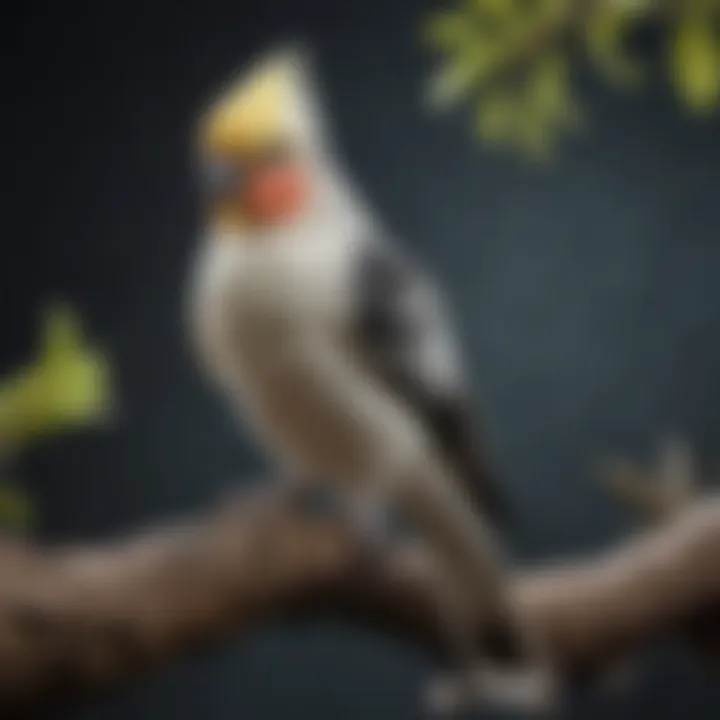
By harnessing these techniques, the search is more comprehensive and focused.
Engaging Local Resources
Besides inspecting your own premises, collaborating with local resources can amplify your efforts to find your cockatiel. Knowing who to involve can extend your search efficiently:
- Inform Neighbors: Share information about the missing bird with your neighbors. Often, they have vigilantly noticed anything unusual in their surroundings. Asking neighbors to check their garages or sheds can yield information.
- Local Animal Shelters: Contact nearby animal shelters and rescue organizations. Visit in person where possible, and leave them with recent pictures of your cockatiel along with your contact information. Sometimes, a kind-hearted individual may bring in found birds.
- Community Boards: Utilize community bulletin boards or classified ads. Printable flyers hung around the neighborhood can also be effective. Be sure to leverage https://reddit.com or relevant Facebook groups dedicated to pet lost and found situations as well.
A collective effort spreads the news further than an individual can alone, thereby enhancing the chances of locating the bird. Overall, combining thorough inspection tactics with community engagement creates a robust approach to finding a lost cockatiel.
Remember, while searching, patience remains essential. Many owners share positive reunion stories where perseverance brought a rewarding outcome. Embrace your concern positively, aligning efforts to foster successful search outcomes.
Recovery Options
Recovery options are essential aspects of the entire process when dealing with a lost cockatiel. Understanding how to approach recovery can significantly impact the likelihood of a successful reunion. Pet owners should act swiftly and strategically, utilizing available resources effectively. Engaging these recovery avenues can lead to increased awareness in the community, improve search efficiency, and ultimately result in the safe return of the threatened bird.
Contacting Animal Shelters and Rescues
Upon realization that a cockatiel is missing, the immediate step should be to contact local animal shelters and rescues. These organizations often receive reports of found birds, making them crucial points of contact. When getting in touch, provide specific details about your cockatiel. Include distinguishing characteristics, such as color patterns, size, any unique markings, or behavior traits. This information will enhance their ability to identify your lost pet among new arrivals.
In addition, many shelters keep a record of lost pets. Registering information about your bird could help significantly if someone finds it. Therefore, persistently follow up with these organizations. Foster open communication, offering your contact information and willingness to provide a photo of your bird.
Key tips are:
- Network: Share the news with them about your bird's disappearance.
- Establish a profile: Explain the background of the cockatiel, including its temperament.
- Build relation: Indicate your appreciation for their work and inquire about their recommendations.
By developing rapport with animal shelters and rescues, owners develop a network of support crucial in times of distress.
Exploring Local Bird Clubs and Organizations
Local bird clubs and organizations represent another vital recovery option when seeking a lost cockatiel. Communicating with these groups can unlock a wealth of resources, knowledge, and tight-knit community support. Members often have experience in caring for birds or recovering lost pets and typically have a shared passion for avian interests.
Involving these organizations can greatly expand your outreach potential. Post on their bulletin boards or social media platforms, describing your bird's characteristics and they can circulate that message to a broader audience. People who understand birds may also extend advice and tips based on personal experiences. This community-driven approach can increase the chances of successful recovery.
Considerations for Engaging with Local Clubs:
- Share Resources: Provide materials or create flyers to circulate among members.
- Attend Meetings: Make potential connections face-to-face to engage different perspectives.
- Utilize Online Platforms: Many clubs maintain social media or websites to connect broader audience.
Emotional Impact of Losing a Cockatiel
The emotional consequences of losing a cockatiel are multifaceted and can deeply affect pet owners. Birds often serve as companions, offering both emotional support and joy in common daily activities. The relationship built between an owner and their cockatiel can be significant, thus making any loss particularly hard to bear. Recognizing this emotional impact influences not only how pet owners respond to their own feelings but also how they may connect with others experiencing similar losses.
Understanding Grief in Pet Owners
Losing a cockatiel can elicit a grief response comparable to the loss of a family member. Each pet has unique traits and behaviors that endear them to their owners, establishing a significant emotional attachment. When a cockatiel goes missing, owners may experience feelings of sadness, anxiety, fear, and guilt. Some common aspects of grief related to pets include:
- Denial: The mentality that initial shock can result in disbelief. Owners may rationalize the situation, thinking they will return.
- Anger: Loss might trigger emotions aimed at both self and circumstances that led to the cockatiel going missing.
- Bargaining: Suspicion might arise, causing owners to re-evaluate their actions before the loss occurred, wishing they could undo them.
- Depression: This often surfaces as a common effect of realizing the permanence of the loss, leading to prolonged sadness.
- Acceptance: Ultimately, although it may take time, recognizing the grief is part of the healing process.
Understanding that these feelings are normal can help owners assess their mental health during such difficult times.
Coping Mechanisms
Once the realization that a cockatiel is lost settles in, it is crucial to adopt effective coping mechanisms for better emotional management. Here are some strategies that might aid in the healing process:
- Connect with Others: Sharing feelings with friends, family, or support groups can provide outlets for emotional expression. Engaging platforms like Reddit and Facebook often have groups specifically for pet owners sharing similar experiences.
- Create Memorable Tributes: Developing a meaningful homage to your lost bird can guide emotions toward positive memories, promoting healing.
- Writing or Journaling: Recording you thoughts about your experience aids in processing feelings and patterns of grief.
- Engaging with Existing Pets: Interacting more with other pet companions can fill the emotional void and help maintain routines to feel valued and needed.
- Seek Professional Help: If grief persists and interferes with daily life, it might be beneficial to consult a professional. Therapists knowledgeable about pet loss provide various coping strategies.
Experiencing loss can be particularly distressing, expecially for cockatiel owners who are dedicated to the emotional welfare of their feathered companions. Providing room tto acknowledge grief ensures a healthier route toward eventual recovery.
Learning from the Experience
Experiencing the loss of a cockatiel can evoke profound feelings of guilt, sadness, and despair for pet owners. However, it can also serve as a pivotal learning experience. Understanding what went wrong and adapting future practices can yield substantial benefits for both owners and birds.
Enhancing Future Preparedness
Preparation is the key to minimizing the risks associated with losing a pal. Evaluation of existing preventive measures is a foundational step. Evaluate your home and surrounding environment for potential escape routes or hazards. Here are a few important practical steps:
- Secure windows and doors: Ensure that screens are intact and securely fitted.
- Distraction tactics: Use toys and food enrichment to keep your cockatiel engaged.
- Regular updates: Keep identification tags or microchipping regularly updated, ensuring that all details are accurate.
In addition to physical changes in the environment, training is essential. Training your cockatiel to respond reliably to recall cues can prove invaluable. This should involve using treats or rewards to encourage the desired behavior. It is advisable to do recall training in a controlled space before permitting outdoor explorations.
By enhancing future preparedness, owners can foster a safer environment for their feathered friends. This, in turn, reduces the chances of repeat incidents of loss.
Building a Stronger Owner-Bird Bond
Strengthening the bond with your cockatiel serves multiple purposes. First, a strong bond leads to a happier, more secure, and less anxious bird. Here are practical elements to foster a better relationship:
- Attentive interaction: Spend time talking, playing, and simply being present. Your cockatiel benefits from your presence.
- Training for engagement: Consider clicker training or other positive reinforcement methods that promote bonding. It helps in trust-building.
- Recognize cues: Understand the body language and vocalizations of your cockatiel. This can guide your understanding of their needs or emotions.
Investing time in enhancing this bond reduces stress and anxiety levels in your cockatiel, minimizing the likelihood of loss due to behaviors stemming from distress.
Key Insight: Taking the time to reflect and adapt improves resilience, comfort, and overall well-being for both the cockatiel and its owner. Through shared experiences and growth, you'll create a meaningful and enduring relationship.















